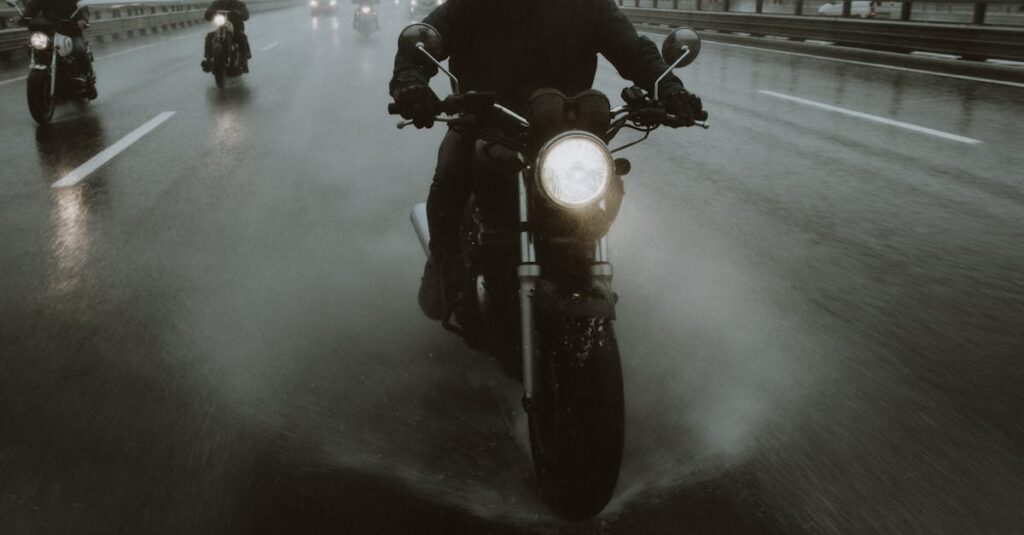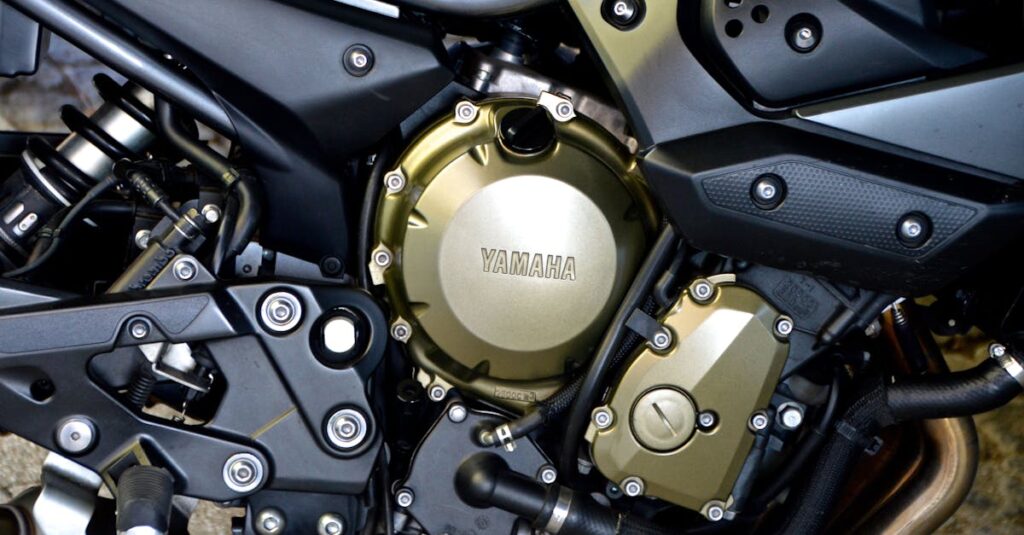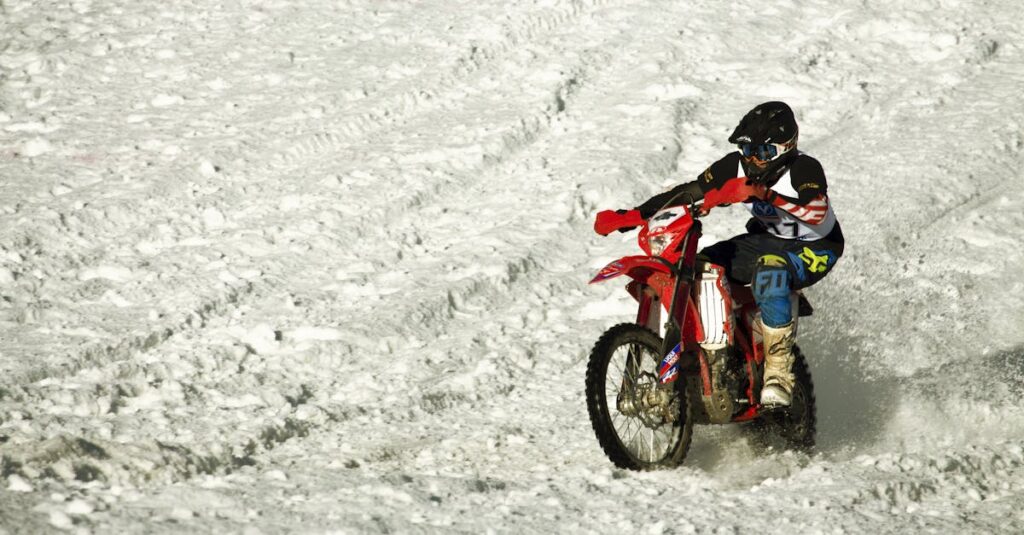Riding a motorcycle in the rain without proper gear is like jumping into a pool fully clothed – uncomfortable and potentially dangerous. Every rider knows that Mother Nature doesn’t always cooperate with their plans but that shouldn’t stop anyone from enjoying the open road.
Quality motorcycle rain gear transforms a wet, miserable ride into an adventure worth taking. From waterproof jackets and pants to boots and gloves modern rain gear technology keeps riders dry and comfortable while maintaining crucial mobility and safety. It’s not just about staying dry – it’s about riding confidently through whatever weather conditions come along.
Rain Gear Motorcycle
A waterproof motorcycle jacket forms the foundation of reliable rain protection. Quality rain jackets feature sealed seams, storm flaps over zippers and adjustable closures at the neck, wrists and waist.
Gore-Tex pants or overalls protect riders’ legs from road spray and rain. Full-coverage pants include elastic waistbands, ankle zippers and reinforced seats for enhanced comfort during long rides.
Here’s a breakdown of essential motorcycle rain gear components:
Primary Protection
- One-piece rain suits with reflective panels for maximum coverage
- Two-piece jacket and pants combinations for versatile layering
- Boot covers extending above the ankles to prevent water seepage
- Gauntlet-style waterproof gloves with grip-enhanced palms
- Breathable materials preventing internal moisture buildup
- Elastic cuffs creating watertight seals at wrists and ankles
- Reinforced knee and elbow areas resisting wear in high-stress zones
- Ventilation zippers regulating temperature in varying conditions
| Rain Gear Type | Key Benefits | Average Lifespan |
|---|---|---|
| One-piece Suit | Maximum coverage, easy to pack | 3-5 years |
| Two-piece Set | Versatile use, better ventilation | 2-4 years |
| Gore-Tex Gear | Superior breathability, durability | 5-7 years |
| Basic Rain Gear | Affordable, lightweight | 1-2 years |
- Anti-fog face shield inserts maintaining clear vision
- Waterproof neck gaiters blocking water entry at the collar
- Quick-dry base layers managing moisture next to skin
- Helmet rain covers preventing water penetration through vents
Types of Motorcycle Rain Suits
Motorcycle rain suits come in two primary configurations: one-piece and two-piece designs. Each style offers distinct advantages for different riding conditions and preferences.
One-Piece Rain Suits
One-piece motorcycle rain suits create a complete waterproof barrier with a single zipper entry system. The seamless design eliminates potential water entry points between separate jacket and pants components. These suits feature elastic cuffs at wrists and ankles, integrated storm flaps over zippers and built-in ventilation panels for temperature regulation. Popular brands like Frogg Toggs and Nelson Rigg manufacture one-piece suits with high-visibility reflective panels and reinforced knee areas. Storage options include chest pockets and side pockets with waterproof zippers. The suits pack down into compact sizes, making them ideal for storage in saddlebags or under-seat compartments.
Two-Piece Rain Gear Sets
Two-piece rain gear sets consist of separate jacket and pants combinations for versatile protection. The jacket components feature adjustable waist straps, removable hoods and multiple pocket configurations. Pants include full-length side zippers for easy on-off while wearing boots. Brands such as Tourmaster and FirstGear produce sets with articulated joints for improved mobility. The separate pieces allow riders to wear just the jacket or pants depending on weather conditions. Premium sets incorporate Gore-Tex or similar waterproof breathable membranes. Connection zippers between jackets and pants create a watertight seal when worn together.
Waterproof Materials and Technology
Motorcycle rain gear employs advanced waterproof materials to keep riders dry in wet conditions. Modern technology combines breathable fabrics with water-resistant properties to create effective protection against rain while maintaining comfort during rides.
Gore-Tex and Similar Fabrics
Gore-Tex leads the motorcycle rain gear industry with its microporous membrane technology. The membrane contains 9 billion pores per square inch, each 20,000 times smaller than a water droplet yet 700 times larger than water vapor molecules. This structure blocks water penetration while allowing sweat to escape, maintaining rider comfort in wet conditions.
Notable alternatives include:
- eVent fabric offers direct venting technology with a 9-micron membrane thickness
- Sympatex provides stretchy waterproof protection with recyclable materials
- HyVent uses multi-layer coating technology with 10,000mm water resistance
- Polartec NeoShell features dynamic air exchange at 0.5 CFM air permeability
Waterproof Coatings and Treatments
Durable Water Repellent (DWR) forms the primary defense against moisture in motorcycle gear. This fluoropolymer coating creates a water-beading surface on fabric fibers.
Key coating technologies include:
- Polyurethane (PU) coating provides 5,000-10,000mm water resistance
- Silicone treatments offer 3-5 years of water repellency
- Nikwax TX.Direct adds wash-in waterproofing for fabric restoration
- Scotchgard creates an invisible barrier with 80% water resistance
| Treatment Type | Water Resistance (mm) | Durability (Washes) |
|---|---|---|
| DWR | 10,000+ | 20-30 |
| PU Coating | 5,000-10,000 | 30-40 |
| Silicone | 3,000-5,000 | 40-50 |
Key Features to Look For
Essential features in motorcycle rain gear enhance both protection and comfort during wet weather rides. The following characteristics are crucial for selecting effective rain protection equipment.
Ventilation and Breathability
Motorcycle rain gear incorporates strategic ventilation points to regulate body temperature during rides. Air vents positioned under the arms, across the back and on the chest allow heat to escape while maintaining waterproof integrity. Premium rain suits feature mesh-lined pockets that double as ventilation zones when opened. Advanced moisture-wicking materials like Gore-Tex combine waterproof protection with breathable properties, allowing sweat vapor to escape through microscopic pores. Zip vents on arms and legs provide customizable airflow control based on weather conditions.
Visibility and Reflective Elements
Reflective materials integrated into motorcycle rain gear create enhanced visibility in low-light conditions. 3M Scotchlite panels placed on shoulders, arms back and legs reflect headlights from distances up to 500 feet. Fluorescent color options like hi-viz yellow orange deliver maximum daytime visibility through rain fog. Strategic reflective piping along seams creates 360-degree nighttime visibility. Some manufacturers incorporate LED light strips into rain gear panels for active illumination during dark wet conditions. Contrasting colors between jacket pants increase overall visibility to other motorists.
Additional Rain Protection Accessories
Motorcycle rain protection extends beyond basic gear to include specialized accessories that enhance rider comfort in wet conditions. These accessories complement primary rain gear to create a complete weather defense system.
Waterproof Boots and Gloves
Waterproof motorcycle boots feature Gore-Tex liners paired with leather or synthetic materials to block water infiltration. Top brands like Alpinestars TCX offer boots with sealed seams, gusseted tongues, adjustable calf panels to prevent water entry. Rain-specific motorcycle gloves incorporate waterproof membranes, extended gauntlets with hook-and-loop closures, visor wipers. Popular options include the Held Rain Star gloves with a textile outer shell, grippy palms, touchscreen compatibility. These accessories maintain optimal grip control while keeping hands dry for 4-6 hours in heavy rain.
Face Shields and Visors
Anti-fog face shields provide clear vision through water-repellent coatings that shed raindrops instantly. Premium options like the Pinlock MaxVision insert create a dual-pane barrier preventing internal fogging in cold wet conditions. Tinted transition shields automatically adjust to changing light levels during rainy weather. Anti-scratch coatings protect against debris impact while maintaining optical clarity. Additional accessories include helmet rain covers with elastic edges, universal rain gutters that redirect water flow away from the rider’s face.
Proper Storage and Maintenance
Motorcycle rain gear maintenance starts with thorough cleaning after each exposure to rain. Store rain suits in a cool dry place away from direct sunlight to prevent material degradation. After cleaning hang garments on padded hangers rather than folding them.
Regular inspections reveal potential issues:
- Check seam seals for separation or wear
- Examine zippers for smooth operation
- Look for tears or punctures in fabric
- Test water repellency on fabric surfaces
Here’s how long rain gear components typically last with proper care:
| Component | Expected Lifespan | Maintenance Frequency |
|---|---|---|
| Rain Suit | 3-5 years | Clean after each use |
| DWR Coating | 1-2 years | Reapply every 20 washes |
| Seam Seals | 2-3 years | Check monthly |
Reapplying water repellent treatments extends gear longevity:
- Clean gear thoroughly before treatment
- Spray DWR coating evenly on outer surfaces
- Heat treat with dryer on medium setting
- Test water beading on surfaces
Storage tips protect gear integrity:
- Use breathable garment bags for storage
- Keep gear away from sharp objects
- Avoid compressed storage in saddlebags
- Store boots upright with boot trees
- Wipe down gear with microfiber cloth
- Air dry gear completely before storage
- Remove dirt from zippers boots
- Clean face shields with appropriate solutions
Motorcycle rain gear stands as an essential investment for any rider who wants to stay safe and comfortable in wet conditions. From advanced waterproof materials to specialized accessories every component plays a vital role in protecting riders from the elements.
By choosing high-quality rain gear with proper features like sealed seams reflective elements and effective ventilation riders can confidently tackle any weather condition. Regular maintenance and proper storage will ensure this protective equipment serves reliably for years to come.
Remember that the right rain gear isn’t just about staying dry – it’s about maintaining safety control and enjoying the ride regardless of what Mother Nature has in store.



